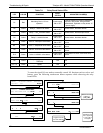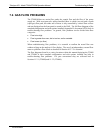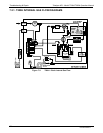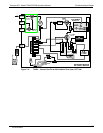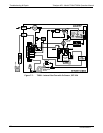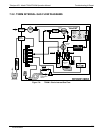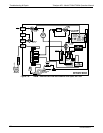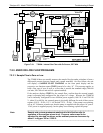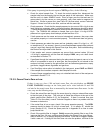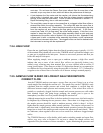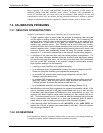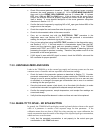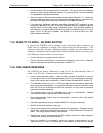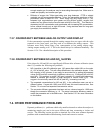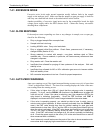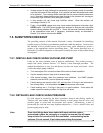
Troubleshooting & Repair Teledyne API - Model T200H/T200M Operation Manual
232
If the pump is operating but the unit reports a XXXX gas flow, do the following:
Check for actual sample flow. To check the actual sample flow, disconnect the
sample tube from the sample inlet on the rear panel of the instrument. Make sure
that the unit is in basic SAMPLE mode. Place a finger over the inlet and see if it
gets sucked in by the vacuum or, more properly, use a flow meter to measure the
actual flow. If there is proper flow (see Table 10-3 for flow rates), contact Technical
Support. If there is no flow or low flow, continue with the next step.
Check pressures. Check that the sample pressure is at or around 28 in-Hg-A at sea
level (adjust as necessary when in elevated location, the pressure should be about
1” below ambient atmospheric pressure) and that the RCEL pressure is below 10 in-
Hg-A. The T200H/M will calculate a sample flow up to about 14 in-Hg-A RCEL
pressure but a good pump should always provide less than 10 in.
If both pressures are the same and around atmospheric pressure, the pump does
not operate properly or is not connected properly. The instrument does not get any
vacuum.
If both pressures are about the same and low (probably under 10 in-Hg-A, or ~20”
on sample and 15” on vacuum), there is a cross-leak between sample flow path and
vacuum, most likely through the Perma Pure dryer flow paths. See troubleshooting
the Perma Pure dryer later in this Section.
If the sample and vacuum pressures are around their nominal values (28 and
<10 in-Hg-A, respectively) and the flow still displays XXXX, carry out a leak check
as described in Section 7.5.
If gas flows through the instrument during the above tests but goes to zero or is low
when it is connected to zero air or span gas, the flow problem is not internal to the
analyzer but likely caused by the gas source such as calibrators/generators, empty
gas tanks, clogged valves, regulators and gas lines.
If an Zero/Span valve option is installed in the instrument, press CALZ and CALS.
If the sample flow increases, suspect a bad Sample/Cal valve.
If none of these suggestions help, carry out a detailed leak check of the analyzer as
described in Section 7.5.2.
7.2.3.2. Ozone Flow is Zero or Low
If there is zero or a low (<200 cm³/min) ozone flow, the unit displays an OZONE
FLOW WARNING message on the front panel and a value between 0.0 and 200
cm³/min for the actual ozone flow as measured by the internal mass flow meter. In this
case, carry out the following steps:
Check the actual flow rate through the ozone dryer by using an external flow meter
to the inlet port of the dryer. This inlet port is inside the analyzer at the end of the
plastic particle filter (Section 6.3.2 for illustration). If there is
nominal flow (see
Table 10-3 for flow rates), consult Technical Support as there is a problem with the
firmware or electronics.
If the actual flow is low or zero, check if the pump operates properly. The RCEL
pressure should be below 10 in-Hg-A at sea level. If it is above 10”, rebuild the
pump (Section 6.3.3). Check the spare parts list in
Appendix B on how to order
pump rebuild kits.
Check if the particle filter is clogged. Briefly remove the particle filter to see if this
improves the flow. Be very cautious about handling the Perma Pure dryer fittings -
refer to Section 6.3.2 on proper handling instructions. If the filter is cl
ogged, replace
it with a new unit. If taking off this filter does not solve the problem, continue to the
07270B DCN6512



